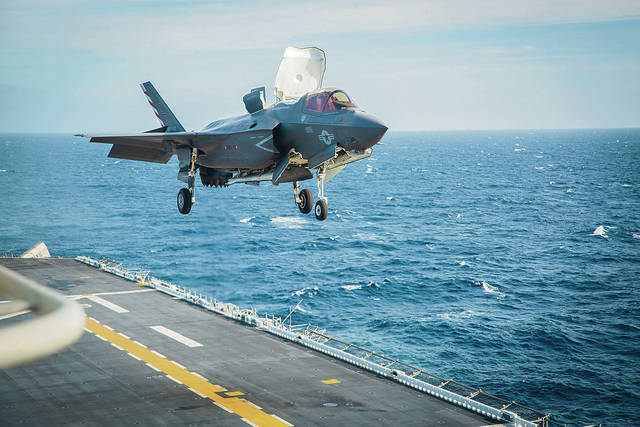The amphibious assault ship USS Wasp pulled into Pearl Harbor on Thursday for a port visit on its way to Japan and the introduction of an F-35B ship-based joint strike fighter capability in the highly charged region that includes North Korea and China.
The 843-foot Wasp is transiting to Sasebo, Japan, to conduct a turnover with the USS Bonhomme Richard as the forward- deployed flagship of the amphibious forces in the Western Pacific.
The stealthy F-35B is the Marine Corps variant of the joint strike fighter and is capable of short takeoffs and vertical landings.
“This move ensures that our most technologically advanced air warfare platforms are forward- deployed,” then-Wasp commander Capt. Andrew Smith said in late August when it left Norfolk, Va. “Our capabilities, paired with the F-35B Joint Strike Fighter, increases our Navy’s precision strike capabilities within the 7th Fleet region. Wasp will help America’s commitment to the maritime security and stability in the Indo-Asia-Pacific.”
The Navy said the Wasp is the centerpiece of what it calls an “up-gunned Expeditionary Strike Group,” which increases the capability of a traditional three-ship amphibious ready group.
The strike group will include amphibious transport dock ship USS Green Bay and one of two forward-deployed amphibious dock landing ships, the Navy said. The ship grouping also will have the 31st Marine Expeditionary Unit and more than 2,200 Marines aboard for deployments.
The Navy said the strike group-Marine Expeditionary Unit team “is the premier crisis response force in the western Pacific. In addition to maintaining security in the region through presence and deterrence, the Wasp ESG will respond at a moment’s notice to any type of contingency, to include humanitarian aid and disaster relief.”
In January the Marine Corps said Marine Fighter Attack Squadron 121, an F-35B squadron, had departed Marine Corps Air Station Yuma, Ariz., and was transferring to Marine Corps Air Station Iwakuni, Japan, as part of a land-based force.
The F-35B stealth fighter, also known as the Lightning II, was developed to replace the Marine Corps’ F/A-18 Hornet, AV-8B Harrier and EA- 6B Prowler.
The Marine Corps called the F-35B a “force multiplier.”
“The unique combination of stealth, cutting-edge radar and sensor technology, and electronic warfare systems bring all of the access and lethality capabilities of a (latest-generation) fighter, a modern bomber, and an adverse-weather, all-threat environment air support platform,” the Marines said.
KOKUA LINE
Christine Donnelly is on vacation. Her column returns Thursday.

